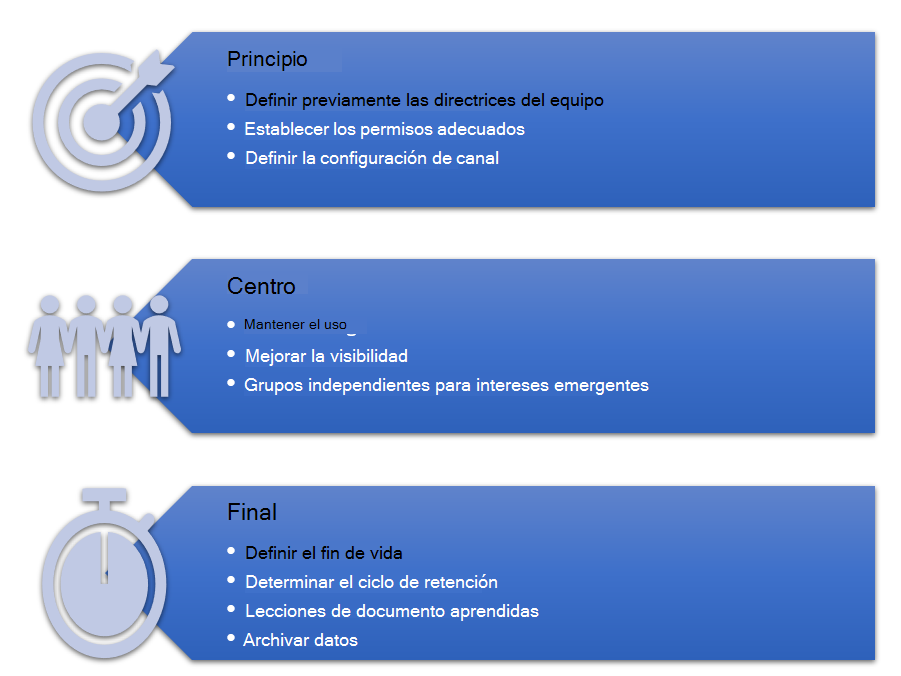Manage the life cycle of a team
Microsoft Teams provides a rich set of tools for implementing collaboration inside your company's environment. As an Enterprise Administrator, it's important to know how to manage these tools. Managing the toolset with Microsoft Teams involves building and executing a project to maximize the longevity of each tool being used in the work environment. The life cycle of most projects consists of a beginning, middle, and end. The life cycle of a team is no different. Having a plan for the life-cycle management of your teams will help you track your organization's teams as they go through these stages.
The life cycle of a team
The following image provides a visual depiction of the life cycle for a Microsoft 365 team.

Stage 1 - Beginning
This stage defines the rest of the life cycle. It's important to set guidelines that your company's employees can use when building their teams, channels, and access types. Guidelines help enforce standardization and consistency of data.
The following guidelines can assist users in creating successful, meaningful teams in Microsoft Teams:
- Define the goal of the team. This goal goes hand in hand with identifying the right people who will be assigned as members of the team. It's a good idea to foster open collaboration by aiming for broad membership. Team owners invite team members, set the team picture and description, and can set permissions for individual team members.
- Define the team’s origins. Teams can originate from various methods. For example, you can create a team from scratch, or you can involve an existing group or SharePoint site. You may also use an API to programmatically create a team based on Global address book attributes such as country/region or department.
- Set up channels. Any team owner or member with the right permissions can create channels in a team. It's important to consider the goal of each channel. Goals can include collaboration around projects, discussions of topics, or areas of common interest.
Additional reading: For more information on organizing your teams, see Best practices for organizing teams in Teams.
Stage 2 - Middle
Once the teamwork begins, the team membership typically develops along with the channel hierarchy. Unless the team must be strictly controlled and locked down, it's a good idea to encourage exploration even if it leads to dead ends. Because teams are living organisms, they must be occasionally reviewed and maintained. Organizations should consider the following best practices when reviewing team development:
- Use champions to sustain usage if it drops.
- Discover and propagate creative new behaviors for the team.
- Manage guests judiciously, making sure their access ends when the business need ends.
- Encourage members to use threaded conversations with subject lines to improve visibility and attention by scrolling through a channel.
- Let channels develop with along with. business needs. Add new channels as necessary and allow old ones to fade. Consider archiving or deleting them if they contain sensitive or ephemeral data, based on your retention requirements.
- Split a team into new teams as larger groups or interest-based areas emerge.
- Try different channel collaborations, such as channel meetings or tab conversations around documents.
- Use the Microsoft Teams mobile app to increase engagement.
Stage 3 - End
It’s important to recognize when the work of a team has run its course. Identifying the end of a team's life cycle gives team members a sense of closure and prevents users from accessing outdated, stale information. You can use the team itself to conduct closure rituals like postmortems and executive summaries. Organizations should consider the following best practices when a team’s life cycle has come to a close:
- Define what the end of a team's life looks like.
- Decide whether to keep the content of a team available, and for how long.
- Document best practices and lessons learned.
- Archive data, if necessary.
Note
A team is deleted with a "soft delete" that IT can reverse for up to 21 days (30 days for Microsoft 365 Groups). Deleting a team doesn't affect any chats or content that was kept under compliance policies. Channels also have a "soft delete" and can be reversed for up to 21 days after deletion. Deleting a channel won't delete the folder or its contents from the SharePoint document library.